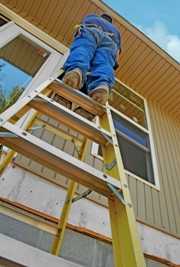With today’s high energy prices, it’s important to make sure your home is using as little energy as possible. Fortunately, living in an efficient home doesn’t have to mean living in an earth hut and dining by candle light. New consumer products are creating more energy savings in single-family homes than ever before, allowing for lower utility bills while adding more market value to the home–and homebuilders are taking notice. Close to 30 percent of all new homes in the last two years have been energy- efficient rated.
However, consumers buying older, less efficient homes aren’t benefitting from these technological changes and utility savings. A key reason for this is the lack of an effective financing or mortgage product. Currently, Energy Efficient Mortgages (EEMs) are available, which go beyond traditional mortgages by giving homebuyers the opportunity to qualify for a larger loan and finance long-lasting efficiency upgrades.
Despite the promise of this mortgage product, which is offered by the Federal Housing Administration, it’s scarce in the marketplace and has some operational issues. The origination process, already a stressful undertaking for conventional loans, is clunky and confusing, turning off many lenders and potential borrowers.
A more streamlined EEM product could offer consumers a way to address uncertainty by offering a chance to add efficiency measures to their conventional mortgages. New homeowners already have to worry about hidden foundation cracks, secret termite infestations, and finding dead rodents in the attic—why provide more to stress about? Along with a more streamlined product, lenders should provide better guidance on how homeowners can make the most effective improvements by engaging a strong network of contractors.
 Contractors are just as important to the mortgage as the lender, as they ultimately help drive the efficiency part of the loan to completion. Energy upgrades are most effective when owners know how these features work, so it is essential that these contractors understand how to work with the homeowner and make sure they know how their new efficient home operates. Install all the low-flow shower heads you want, but the two hours your family spends in the shower every morning is still a lot of hot water and money down the drain.
Contractors are just as important to the mortgage as the lender, as they ultimately help drive the efficiency part of the loan to completion. Energy upgrades are most effective when owners know how these features work, so it is essential that these contractors understand how to work with the homeowner and make sure they know how their new efficient home operates. Install all the low-flow shower heads you want, but the two hours your family spends in the shower every morning is still a lot of hot water and money down the drain.
Despite these current limitations, EEMs have strong potential. They could enable homeowners to realize significant savings on energy expenses, improve the longevity of the home, and increase the house’s potential market value almost immediately.
A recent study conducted by Nils Kok, co-founder of the Global Real Estate Sustainability Benchmark (GRESB), found that green homes sold for 9 percent more than comparable homes in a Southern California market. And a 2013 University of North Carolina study commissioned by IMT showed borrowers who live in more efficient buildings are 32 percent less likely to default on their loan. Both of these studies offer proof and incentive for lenders to provide loans that factor in energy efficiency. Lower monthly expenses, increased market value, and a less risky borrower should make an EEM a fairly win-win situation. And unless lenders act to offer a more streamlined product, EEMs, their unrealized potential will remain in the dark.
Fortunately, the US Department of Housing and Urban Development (HUD) is actively working with key lenders and industry players to address the current issues with EEMs. As they work to offer an even better product, there is hope yet that Energy Efficient Mortgages can become the next big thing.
Sarah Gilcrest is an intern on IMT’s finance team where she’s currently working on green appraisal policies within DC and is helping put together educational materials and roundtables. She also works with the DC Sustainable Energy Utility on furthering their engagement within the commercial real estate industry and is supporting their benchmarking efforts.
